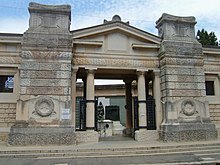Cimitero Monumentale della Certosa di Bologna
The Cimitero Monumentale della Certosa di Bologna is the older of two cemeteries in Bologna.
Location and structure
It is located west of the former city wall, near the Stadio Renato Dall'Ara , at the foot of the Colle della Guardia , on which the pilgrimage church Santuario della Madonna di San Luca stands, and covers an area of around 30 hectares. The Canale di Reno runs south of the site . In addition to the general Roman Catholic cemetery, the area also includes the Protestant cemetery located outside the enclosure, as well as the Jewish cemetery of Bologna , which is also separate . Muslims, Orthodox Christians and Baha'i have their own grave fields on the Cimitero di Borgo Panigale . Both cemeteries are operated by the Bologna Servizi Cimiteriali Srl , which is 51% urban and 49% owned by SPV Bologna Spa .
The Certosa has four entrances, clockwise these are the Entrata Principale , where the administration and the crematorium are located, the Entrata Monumentale , the Entrata Ghisello and the Entrata Campo 1971 . The facility is divided into two main areas of roughly the same size; the several times expanded, multi-storey and partly subterranean Nucleo ottocentesco with its labyrinthine layout and the fields of Campo Nuovo , laid out with row and niche graves , which were created between 1942 and 1971.
The Certosa contains a large number of art-historically significant tombs. Particularly well-known are the Montanari family grave from 1891 and the Cella Magnani by the Bolognese sculptor Pasquale Rizzoli from 1904, in Liberty style, the Italian form of Art Nouveau .
The municipal cemetery was laid out in 1801 , using the existing structures of the Carthusian monastery of San Girolamo di Casara, which was founded in the 14th century and dissolved by Napoleon in 1797 .
tourism
The passion that aristocrats and commoners developed for the construction of family tombs transformed the Certosa into a veritable “open-air museum”, which became a point of visit for many trips to Italy; Visitors include Chateaubriand , Byron , Dickens , Mommsen , Stendhal . In addition to guided tours, concerts are also held in the warm season. There is an information room for interested visitors at the main entrance.
Graves of famous people

In the cemetery are the graves of numerous people who were important for the history of Bologna and Italy, including:
- Adolfo Albertazzi , writer
- Cesare Albicini , lawyer and politician
- Giuseppe Albini , philologist and politician
- Riccardo Bacchelli , journalist and writer
- Marco Biagi , lawyer
- Adelaide Borghi , singer
- Dino Bovoli , footballer
- Edoardo Brizio , archaeologist
- Carlo Broschi called Farinelli , singer
- Cristina Campo , poet and translator
- Giovanni Capellini , geologist and paleontologist
- Giosuè Carducci , winner of the Nobel Prize for Literature, alongside some of his followers
- Giuseppe Ceneri , politician
- Isabella Colbran , wife of Gioacchino Rossini
- Lucio Dalla , singer
- Giuseppe Dozza , architect and politician
- Pericle Ducati , automobile pioneer
- Severino Ferrari , poet and novelist
- Adolfo Gandino , composer
- Giovanni Gandino , philologist
- Stefano Gobatti , composer
- Stefano Golinelli , composer and pianist
- Giuseppe Grabinski , General
- Luigi Heilmann , linguist
- Alfieri Maserati , automobile pioneer
- Marco Minghetti , politician
- Giorgio Morandi , painter and printmaker
- Letizia Murat , daughter of Gioacchino Murat and Carolina Bonaparte
- Enrico Panzacchi , poet and politician
- Gioacchino Napoleone Pepoli , politician
- Olindo Raggi , motorcycle racer
- Ottorino Respighi , composer
- Guido Reni , painter and etcher
- Amedeo Ruggeri , racing driver
- Bruno Saetti , painter
- Antonio Santucci , astronomer
- Alfredo Testoni , writer
- Luigi Vannucchi , actor and director
- Mariele Ventre , conductor
- Assunta Viscardi , Blessed
- Eduardo Weber , designer and entrepreneur
- Nicola Zanichelli , publisher
- Anteo Zamboni , anarchist
In the Protestant cemetery:
- Carlo Maria Viola , geologist
- August Wilhelm Boesen , painter
literature
- Sara Benuzzi, Michela Cavina, Melissa La Maida, Roberto Martorelli: Guida Certosa di Bologna . A cura di Roberto Martorelli, Edizioni Minerva, Argelato 2016. ISBN 978-88-7381-899-1 .
- Gian Marco Vidor: Biografia di un cimitero italiano - La Certosa di Bologna . Società editrice il Mulino, Bologna 2012. ISBN 978-88-15-24063-7 .
Web links
- Official website
- Image database with search options for location, person, iconography
- Exhibition 2001: "La Certosa di Bologna, photography di Guido Piacentini"
- "cartusialover": fansite (ital.)
Individual evidence
- ^ Renato Zoppelli: August Wilhelm Boesen. In: Find a Grave . December 21, 2019, accessed April 23, 2020 .
Coordinates: 44 ° 29 ′ 47 " N , 11 ° 18 ′ 34.2" E



